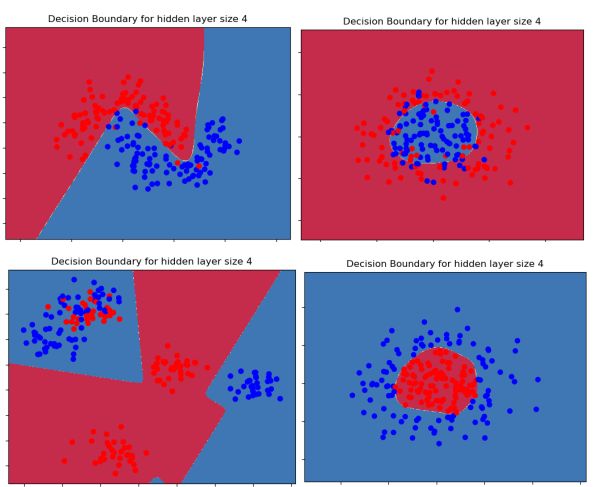吴恩达Coursera深度学习(1-3)编程练习
练习部分解释:跟网上大多数博客都不一样,因为之前我已经在notebook上做完了,再总结一遍放在博客上。
Class 1:神经网络和深度学习
Week 3:浅层神经网络——编程练习
目录
- Class 1神经网络和深度学习
- Week 3浅层神经网络编程练习
- 目录
- 1数据集
- 2简单线性逻辑回归模型
- 3神经网络模型
1、数据集
- planar_utils.py
import matplotlib.pyplot as plt
import numpy as np
import sklearn
import sklearn.datasets
import sklearn.linear_model
def sigmoid(x):
s = 1/(1+np.exp(-x))
return s
def load_planar_dataset():
np.random.seed(1)
m = 400 # 样本总数
N = int(m/2) # 每类样本数
D = 2 # 维度
X = np.zeros((m,D)) # 初始化,每行是一个样本
Y = np.zeros((m,1), dtype='uint8') # 标签 (0 for red, 1 for blue)
a = 4 # 花的最大长达
for j in range(2):
ix = range(N*j,N*(j+1))
t = np.linspace(j*3.12,(j+1)*3.12,N) + np.random.randn(N)*0.2 # theta
r = a*np.sin(4*t) + np.random.randn(N)*0.2 # radius
X[ix] = np.c_[r*np.sin(t), r*np.cos(t)]
Y[ix] = j
X = X.T
Y = Y.T
return X, Y
def setcolor(x):
color=[]
for i in range(x.shape[1]):
if x[:,i]==1:
color.append('b')
else:
color.append('r')
return color
def load_extra_datasets():
N = 200
noisy_circles = sklearn.datasets.make_circles(n_samples=N, factor=.5, noise=.3)
noisy_moons = sklearn.datasets.make_moons(n_samples=N, noise=.2)
blobs = sklearn.datasets.make_blobs(n_samples=N, random_state=5, n_features=2, centers=6)
gaussian_quantiles = sklearn.datasets.make_gaussian_quantiles(mean=None, cov=0.5, n_samples=N, n_features=2, n_classes=2, shuffle=True, random_state=None)
no_structure = np.random.rand(N, 2), np.random.rand(N, 2)
return noisy_circles, noisy_moons, blobs, gaussian_quantiles, no_structure
def plot_decision_boundary(model, X, y):
# 设置数据的边界,并向外扩充一点
x_min, x_max = X[0, :].min() - 1, X[0, :].max() + 1
y_min, y_max = X[1, :].min() - 1, X[1, :].max() + 1
h = 0.01
# 生成以 h 为步长的格子
xx, yy = np.meshgrid(np.arange(x_min, x_max, h), np.arange(y_min, y_max, h))
# Predict the function value for the whole grid
# ravel()与flatten()都是平铺
# np.r_按行组合array,np.c_按列组合array
Z = model(np.c_[xx.ravel(), yy.ravel()])
Z = Z.reshape(xx.shape)
# Plot the contour and training examples
# contourf(x,y,f(x,y),alpha=0.75,cmap='jet')
plt.contourf(xx, yy, Z, cmap=plt.cm.Spectral)
plt.ylabel('x2')
plt.xlabel('x1')
color = setcolor(y)
plt.scatter(X[0, :], X[1, :], c=color, cmap=plt.cm.Spectral)
if __name__=="__main__":
X,Y = load_planar_dataset()
print(X.shape,Y.shape)
color =setcolor(Y)
# 显示花
plt.scatter(X[0,:],X[1,:],s=20,c=color,cmap=plt.cm.Spectral)
#plt.show()
(2, 400) (1, 400)2、简单线性逻辑回归模型
import numpy as np
import matplotlib.pyplot as plt
import sklearn
import sklearn.datasets
import sklearn.linear_model
from testCases import *
from planar_utils import sigmoid,plot_decision_boundary,load_planar_dataset,load_extra_datasets
# 1、下载数据集
np.random.seed(1) # 设定一个种子,保证结果的一致性
X,Y = load_planar_dataset()
shape_x = X.shape
shape_y = Y.shape
m = X.shape[1] #训练集大小
print(shape_x,shape_y,m)
# 2、简单的逻辑回归
# 训练逻辑回归分类器
clf = sklearn.linear_model.LogisticRegressionCV() #创建分类器对象
clf.fit(X.T,Y.T) #用训练数据拟合分类器模型
# 画逻辑回归的分界线
plot_decision_boundary(lambda x: clf.predict(x), X, Y) #用训练好的分类器去预测新数据
plt.title("Logistic Regression")
plt.show()
# 预测正确率,数据集不是线性可分的,所以逻辑回归表现不好
LR_predictions = clf.predict(X.T)
print(Y.shape,LR_predictions.shape)
LR_accuracy = (np.dot(Y,LR_predictions)+np.dot(1-Y,1-LR_predictions))/Y.size*100
print ('Accuracy of logistic regression: %d' % LR_accuracy +'%')
(1, 400) (400,)
Accuracy of logistic regression: 47%3、神经网络模型
import numpy as np
import matplotlib.pyplot as plt
import sklearn
import sklearn.datasets
import sklearn.linear_model
from testCases import *
from planar_utils import sigmoid,plot_decision_boundary,load_planar_dataset,load_extra_datasets
# 下载额外的数据集
np.random.seed(1) # 设定一个种子,保证结果的一致性
noisy_circles, noisy_moons, blobs, gaussian_quantiles, no_structure = load_extra_datasets()
datasets = {"noisy_circles": noisy_circles,
"noisy_moons": noisy_moons,
"blobs": blobs,
"gaussian_quantiles": gaussian_quantiles}
dataset = "blobs"
X,Y = datasets[dataset]
X,Y = X.T,Y.reshape(1,Y.shape[0])
if dataset == "blobs":
Y = Y % 2
print(X.shape, Y.shape, X.shape[1])
def setcolor(Y):
color=[]
for i in range(Y.shape[1]):
if Y[:,i]==1:
color.append('b')
else:
color.append('r')
return color
#显示数据
plt.scatter(X[0,:], X[1:], s=30, c=setcolor(Y), cmap=plt.cm.Spectral)
plt.show() #加上才显示
# 3、神经网络模型
# 3-1 定义三层网络结构
def layer_sizes(X,Y):
n_x = X.shape[0]
n_h = 4
n_y = Y.shape[0]
return (n_x,n_h,n_y)
# 3-2 初始化模型参数
def initialize_parameters(n_x,n_h,n_y):
np.random.seed(2)
W1 = np.random.randn(n_h,n_x)
W2 = np.random.randn(n_y,n_h)
b1 = np.zeros((n_h,1))
b2 = np.zeros((n_y,1))
assert(W1.shape == (n_h,n_x))
assert(W2.shape == (n_y,n_h))
assert(b1.shape == (n_h,1))
assert(b2.shape == (n_y,1))
parameters = {"W1":W1, "W2":W2, "b1":b1, "b2":b2}
return parameters
# 3-3 计算前向传播
def forward_propagation(X,parameters):
W1 = parameters["W1"]
W2 = parameters["W2"]
b1 = parameters["b1"]
b2 = parameters["b2"]
Z1 = np.dot(W1,X) + b1
A1 = np.tanh(Z1)
Z2 = np.dot(W2,A1) + b2
A2 = sigmoid(Z2)
#assert(A2.shape == (1,X.shape[1]))
cache = {"Z1":Z1, "Z2":Z2, "A1":A1, "A2":A2}
return A2,cache
# 3-4 计算损失函数
def compute_cost(A2,Y,parameters):
m = Y.shape[1]
#计算交叉熵损失函数
logprobs = np.multiply(np.log(A2),Y) + np.multiply(np.log(1-A2),1-Y)
cost = -np.sum(logprobs)/m
cost = np.squeeze(cost)
assert(isinstance(cost,float))
return cost
# 3-5 计算反向传播过程
def backward_propagation(parameters,cache,X,Y):
m = X.shape[1]
W1 = parameters["W1"]
W2 = parameters["W2"]
A1 = cache["A1"]
A2 = cache["A2"]
dZ2 = A2-Y
dW2 = 1/m * np.dot(dZ2,A1.T)
db2 = 1/m * np.sum(dZ2, axis=1, keepdims=True)
dZ1 = np.dot(W2.T,dZ2) * (1-np.power(A1,2))
dW1 = 1/m * np.dot(dZ1,X.T)
db1 = 1/m * np.sum(dZ1, axis=1, keepdims=True)
grads = {"dW1":dW1, "dW2":dW2, "db1":db1, "db2":db2}
return grads
# 3-6 更新参数
def update_parameters(parameters,grads,learning_rate=1.2):
W1 = parameters["W1"]
W2 = parameters["W2"]
b1 = parameters["b1"]
b2 = parameters["b2"]
dW1 = grads["dW1"]
dW2 = grads["dW2"]
db1 = grads["db1"]
db2 = grads["db2"]
W1 -= learning_rate * dW1
W2 -= learning_rate * dW2
b1 -= learning_rate * db1
b2 -= learning_rate * db2
parameters = {"W1":W1, "W2":W2, "b1":b1, "b2":b2}
return parameters
# 3-7 模型
def nn_model(X, Y, n_h, num_iterations=10000, print_cost=False):
np.random.seed(3)
n_x = layer_sizes(X, Y)[0]
n_y = layer_sizes(X, Y)[2]
parameters = initialize_parameters(n_x, n_h, n_y)
W1 = parameters["W1"]
W2 = parameters["W2"]
b1 = parameters["b1"]
b2 = parameters["b2"]
for i in range(0,num_iterations):
A2, cache = forward_propagation(X, parameters)
cost = compute_cost(A2, Y, parameters)
grads = backward_propagation(parameters, cache, X, Y)
parameters = update_parameters(parameters, grads, learning_rate=0.3)
if print_cost and i%100==0:
print("cost after iteration %i: %f" % (i,cost))
return parameters
# 3-8 预测
def predict(parameters, X):
A2,cache = forward_propagation(X,parameters)
predictions = np.around(A2)
return predictions
# 3-9 运行测试代码
# 下载数据,训练模型
parameters = nn_model(X, Y, n_h=4, num_iterations=10000, print_cost=True)
# 预测正确率
predictions = predict(parameters, X)
print(Y.shape,predictions.shape)
accuracy = float(np.dot(Y,predictions.T)+np.dot(1-Y,1-predictions.T))/Y.size*100
print('Accuracy : %d' % accuracy +'%')
# 画边界
plot_decision_boundary(lambda x: predict(parameters, x.T), X, Y)
plt.title("Decision Boundary for hidden layer size " + str(4))
plt.show()
(1)学习率大,收敛速度快,但容易过拟合

(2)神经网络建立模型步骤:
定义网络结构,初始化参数、前向传播、计算损失函数、后向传播、更新参数

正确率 91%,非线性的分类平面
(3)不同隐含层,分类正确率不同,隐含层太少,拟合函数不复杂


(4)其他数据集正确率 96%,81%,83% ,100%


